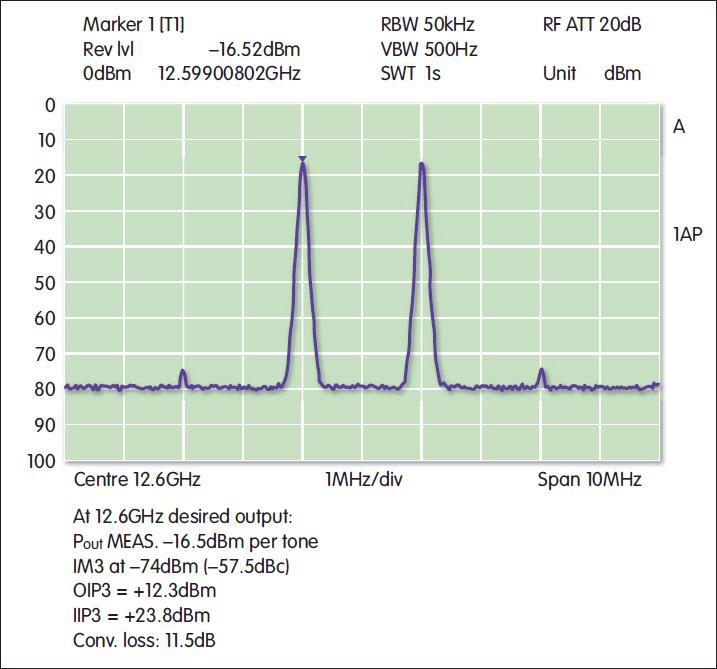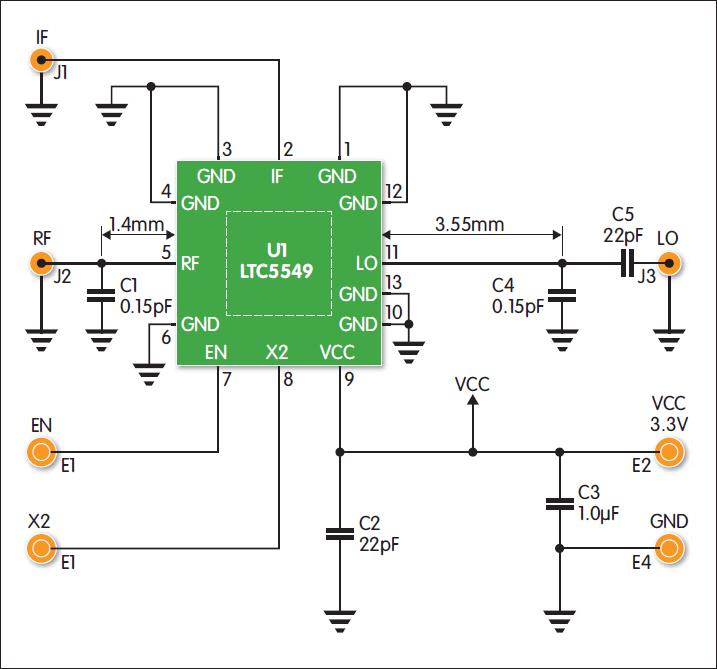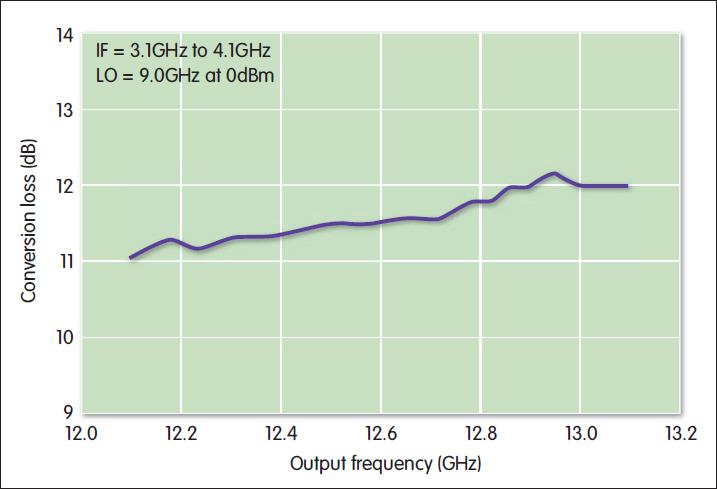It is a passive double-balanced mixer that can function as either an up- or downconverter. It has a very wide RF operating frequency range from 2GHz to 14GHz.
The LTC5549 offers high linearity of 28.2dBm IIP3 at 5.8GHz, and 22.8dBm at 12GHz, improving the dynamic range of both transmitters and receivers alike and it enables efficient microwave transmitter and receiver designs with its integrated LO buffer that needs only a 0dBm drive level, effectively eliminating extra external high power LO driver circuits. Moreover, the LTC5549 has an integrated on-chip, by-passable frequency doubler for the LO signal, allowing the device to use lower cost, commonly available low-frequency synthesizers, where advantageous.
The LTC5549 employs wideband integrated balun transformers optimised to extend the LO and RF frequency bandwidth while enabling single-ended operation. And its IF port can support wide bandwidth from 0.5 to 6GHz. All three ports are 50O matched and have excellent port-to-port isolation, minimising undesirable LO leakage, thus easing external filtering requirements.
Fig 1: The 3rd Order Intermodulation spurs are measured at -74 dBm, suggesting an IIP3 performance of +23.8dBm at the 12.6GHz frequency. |
Transceiver performance improved
Most microwave mixers are built using discrete GaAs diodes or FETs in hybrid modules. In contrast, the LTC5549 is constructed using a very high frequency advanced SiGe BiCMOS process. A high level of integration is achieved, including an on-chip LO buffer and microwave balun transformers. The monolithic die is flipped and soldered onto a tiny 3 x 2mm lead-framed, plastic surface mount package. Bond wires are eliminated to greatly enhance the device’s microwave frequency performance without introducing bond wire inductances. Its inherently small package, along with minimum external circuitry, makes for a very small solution footprint.
According to Linear the new mixer’s 22.8dBm IIP3 performance is ‘standout’ in its class. The improved performance enhances the dynamic range of receivers or transmitters. For a receiver, the higher IIP3 boosts the robustness when in the presence of close-in high power interference, either from out-of-band unintentional emitter sources or self-induced (leak through from another transmitter in multi-sectored systems). Higher dynamic range receivers provide added design margin and therefore are more forgiving in handling high blockers – as airwaves continually degrade over time with ever-increasing radio deployments.
Similarly for transmitters, a higher IIP3 (hence higher OIP3) mixer helps to produce less spurious products and thus improved the spectral purity and better ACPR performance. This is particularly important for radios that use higher order modulations which can push upward of 1024 QAM or higher. The improved linearity helps to produce better definition of the constellation accuracy. Additionally, higher IIP3 allows the mixer to operate at elevated input power, and therefore more robust output power levels. The extra design margin helps to ease design constraints, providing flexibility.
The LTC5549’s integrated LO amplifier effectively eliminates the +10dBm to +17dBm LO amplifier that is typically required to drive the traditional microwave passive mixers.So its 0dBm LO drive enables the LO to be driven directly from a PLL/synthesizer without buffering. Besides saving costs, the low LO power inherently produces significantly lower LO leakage to either the IF or the RF ports, so less external filtering is necessary to contain any out-of-band emission associated with such a high power source. Another benefit is not having a high power radiation source on the PC board. This has a significant cost savings implication because it lessens the need for RF containment shielding which plagues many designs that have such high power LO signals.
|
Bandwidth improved
The LTC5549 incorporates patent-pending advances in planar balun transformer designs, enabling the monolithic mixer to operate over extremely wide bandwidth. Unprecedented symmetry is achieved, producing exceptional balanced operation and resulting in optimum spurious cancellation and flat frequency response over very wide bandwidth. For example, the 50O matched RF port with its built-in transformer and a 0.15pF external capacitor exhibits return loss better than 10dB from 2GHz to 14GHz continuously. Similarly, by connecting a 0.15pF shunt capacitor and a series capacitor at the LO input, the port is 50O matched from 1GHz to 12GHz. Return loss is better than 10dB across that entire frequency range.
There goes the bandwidth
5G wireless is expected to deliver 1Gbps. In order to achieve such speeds, the bandwidth will need to be pushed upward to 1GHz or higher. Invariably, new spectrums need to open up. The LTC5549 has excellent bandwidth that can support a flat response of more than 1GHz.
Microwave test equipment can also benefit from a compact, high linearity mixer such as the LTC5549. As RF test equipment pushes higher frequencies, their linearity and bandwidth performance must also be improved in order to keep pace with the progression in performance of the device-under-test.
Fig 3: The up-conversion mixer exhibits a conversion loss of 12dB, with a flatness of 1dB over a 1GHz bandwidth at the 12.6GHz carrier. |
Example Design: A 3.6GHz to 12.6GHz band up-conversion application
Consider an application example that converts a 3.6GHz signal to a 12.6GHz carrier. A low-side LO is used. The operating conditions are as follows:
- IF port (input) = 3.6GHz
- RF port (output) = 12.6GHz
- LO (input) =9GHz, at 0dBm
- Two tones input, 2MHz separation inputs, -5dBm each at the IF input
Performance measurements were made with a LTC5549 evaluation board (main pic). The internal 2X LO is bypassed so a 9GHz LO signal is directly injected using a clean laboratory signal generator. Because the evaluation board’s components are already broadband matched, it is used as is without alteration.
Figure 1 shows this mixer’s linearity performance with two tones at 2MHz separation measured at 12.6GHz. The output 3rd order intermodulation distortion spurs measured -57.5dBc down. This corresponds to an IIP3 of +23.8dBm. Figure 2 shows the complete spectral plot of the RF output. No external filter is used so we can see where all the spurious products fall. The LO leakage is some 14dB down below the 12.6GHz carrier but is 3.6GHz away. So filtering should not be much of an issue. The closest spur is actually the 2LO-IF, occurring at 1.8GHz away from the carrier. The good news is its residual power is better than -40dBc below the carrier.
At 12.6GHz, the mixer’s output exhibits 1dB flatness over a 1GHz bandwidth (see figure 3), capable of supporting next generation broadband radios.
Conclusion
The LTC5549 exhibits excellent IIP3 that can enhance the dynamic range performance for either receiver or transmitter applications. It has an integrated LO buffer, saving costs and producing very low LO leakage. Its integrated on-chip balun transformers provide extraordinarily wide bandwidth to simplify designs and enable a very compact solution size.
Author details: Bruce Hemp, applications section leader and James Wong, product marketing manager, Linear Technology









 Fig 2: Wideband Output Spectrum shows all the spurious products which affect the output filter requirements.
Fig 2: Wideband Output Spectrum shows all the spurious products which affect the output filter requirements.





